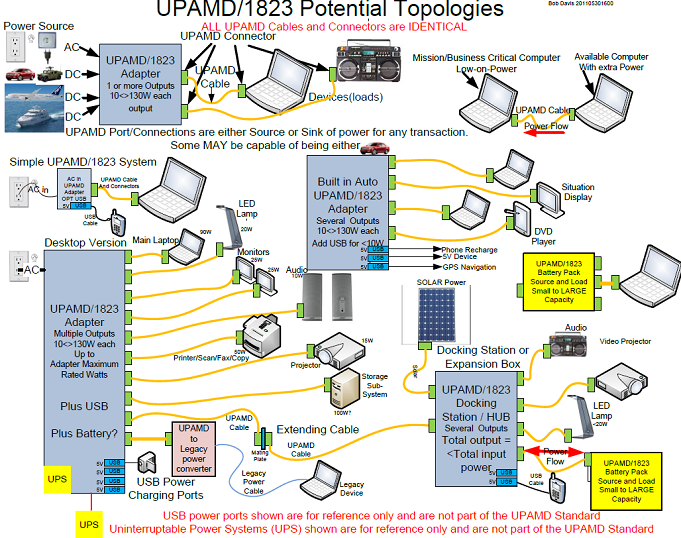UPAMD,
As discussed in the meeting yesterday, and for the past year in the Power Subcommittee meetings, there has been a request to extend the range of the UPAMD power from the current 10Watts to 130Watts to an increased range of 10Watts up to 240VA(Watts).
This request has be forwarded by the both Dell and HP to service printers, at higher voltages, and larger work stations at higher power.
Following the next UPAMD Working group meeting, I will conduct an email ballot to approve or disapprove the following question:
“Should UPAMD change the upper bound of the permissible delivered power from 130Watts, as specified in the PAR, to up to 240Watts?”
Above 240VA is considered hazardous power. Above 60VDC is considered hazardous voltage.
To reach this higher power limit, the voltage would need to be negotiated to a higher voltage level to stay within the current limitations of the connector pins. The current connector pins have a rating of 9 to 10Amps depending on the vendor. If we assume a working current level of no more than ~6.5-7 Amps, we have good design margin on each pin and the pins are redundant. The higher voltages are never available on a connector unless the connector is seated, and communication is established.
We should also raise the maximum negotiated voltage to be up to 60VDC. This keeps the system in the SELV voltage range. The connector, as currently specified, has a creepage and clearance rating in a Pollution Degree 3 environment, of 63VDC. The nominal voltage would remain at 20VDC at the load end of the cable.
What does this mean to the use of the UPAMD Standard?
1. A broader set of served devices. The US DOE has listed the target markets in the battery charger and external power supply markets and the number of units shipped to the US in http://grouper.ieee.org/groups/msc/upamd/private/US_DOE/bceps_preanalysis_app3a.pdf and the units shipped of >500 million, in the spread sheets in the same directory.
2. This does not change the low energy connect and disconnect or the default voltage of about 20V delivered at the end of the cable, depending on cable resistance.
3. The connector probe voltage is currently targeted at 3-5V with a series 1-3K resistor. Communications voltage of 12V is limited to 25ma until communications established. Higher voltage and/or current is negotiated between sink and source.
4. No change to the goal of any vendor offering a single port adapter with a rated power anywhere between 10 and now 240W to meet the target market they feel is appropriate for that power adapter. The Vendors that may want to build multi-ported power adaptor are also free to make all the ports the same power capable or tailor some for higher power and some for lower power to save on building costs.
5. No power adapter would be required to offer any more than the standard ~20V power output, but it must stay within the pin current rating of the connector.
6. No sink will be required to accept anything other than the standards 20V.
7. All smart, communicating sink devices will need to make a decision of what the minimum power they can perform any task with, from filling a battery only overnight to full power operation plus battery charging. (how to indicate this on systems with no display needs to be address – red led for bad insufficient power, green for good workable, possibly not ideal power?)
8. Non-communicating devices, after detection, can have up to 1A @ 20V. (Does this mean the minimum adapter needs to be at least 20W? or do we reduce the dumb device to 10W = 20V @0.5A?) ( The 20W minimum adapted could still power a 10W device or a 5W LED desk lamp)
I really believe that we will have many smaller power devices ~<25W and a few bigger ones.
The really small devices and phones can charge with additional built-in USB ports(not part of UPAMD).

Any comment, suggestions, welcome.
Respectfully;
Bob Davis
Chair UPAMD/P1823
bobd@xxxxxxxx
408.353.5990 desk
408.857.1273 cell
bob.davis.scsi.com Skype